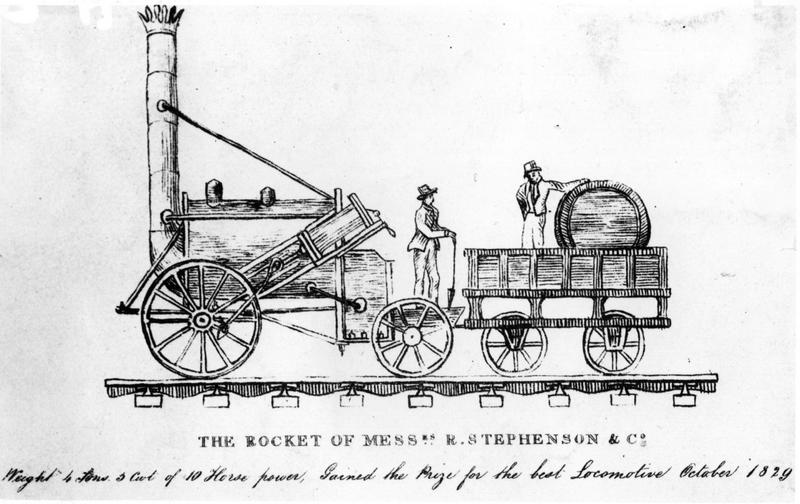Inventions of English Inventors of the 1800s
By | November 23, 2018
October 1829: Stephenson's Rocket (Photo by Hulton Archive/Getty Images)
Designed by English railway engineer Robert Stephenson, winner of the prize for the best locomotive in a contest of steam engines at Rainhill, on the Liverpool and Manchester Railway.
Many of the products and devices that have been used throughout history were created back in the 1800s by English inventors such as the railways and locomotives. These inventors took their work seriously and put their knowledge to good use.
Robert Stephenson, born in 1803, was an English railway and civil engineer, who was called the greatest engineer of the 19th century. He had his father, George Stephenson’s ingenuity of railways. While his father was building the Liverpool and Manchester Railway, Robert established the steam locomotive “Rocket” in 1829. In 1833, while Robert was not even 30 years old yet, he signed a contract to build a 112-mile railway from Camden Town to Birmingham. Robert was made Knight of the Order of Leopold in 1941 for his enhancements to locomotive engines. By 1850, he had designed the “High-Level Bridge,” the “Royal Border Bridge,” and the “East Coast Main Line.”
John Braithwaite was an English engineer, born in London in 1797, who invented the first steam fire engine. Being the third son and named after his father, he became a skilled draughtsman and a master of practical engineering. When his father died in 1818, John and his brother, Francis took over their father’s business. Just five years later, his brother Francis died and he alone worked the business. John began incorporating into the business the making of high-pressure steam engines. By 1827, he met Captain John Ericsson, who he connected with and they constructed the locomotive engine which they called “The Novelty.” It was the first engine to ever run a mile within a minute. The first steam fire-engine that Braithwaite manufactured was destroyed by a mob in London. Before it was destroyed, though, it was successful in subsiding fires at the English Opera House and some others. Because it was so successful in its operation, there was so much jealousy by the fire brigade that Braithwaite had to give it up. But it wasn’t long before he constructed four more of larger dimensions.
Born in 1792, John Herschel was an English mathematician, astronomer, chemist, and inventor who invented blueprints. Included in his achievements, he also experimented with photography and did botanical work as well. He took up astronomy in 1816 and became one of the founders of the Royal Astronomical Society in 1820. In 1831, he became a Knight of the Royal Guelphic Order. His knowledge of astronomy helped him to originate the use of the Julian day system. Regarding photography, he investigated color blindness and ultraviolet rays. Considering astigmatism to be caused by an abnormality of the cornea, he theorized that vision could be improved by an animal jelly put into a capsule of glass beside the cornea.
Robert Whitehead, born in 1823, was a famous English engineer who developed a self-propelled naval torpedo that turned out to be the first one that was effective. Before he was successful in his development, he and his 12-year-old son performed experiments, eliminating the previous concept by his partner, Luppis. In 1860, he and Luppis had formed a partnership after Luppis had fashioned his first prototype of a self-propelled torpedo that was propelled by compressed air and controlled by ropes from land. Whitehead and his son’s torpedo was an unguided torpedo that could be launched from a ship on a straight line. They named it the Whitehead torpedo. By 1870, he had been able to increase the speed to 7 knots and hit a target 700 yards away.
Born in 1781, George Stephenson, Robert Stephenson’s father, was known as the “Father of Railways. His “rail gauge” of 4 feet 8 ½ inches became the standard gauge for most of the world’s railways. In the 19th century, his technological inventions were most important and a key component of the Industrial Revolution. George and his son built the Locomotion No. 1 which was the first steam engine to carry passengers. George also built the Liverpool and Manchester Railway which opened in 1830. This railway was the first public inter-city railway in the world to use locomotives.
Frederick Walton, born in 1834, was an English Linoleum manufacturer and inventor. His invention of linoleum was patented in 1863. Besides linoleum, he also invented Lincrusta in 1877, which is an embossed wallcovering that was used in royal homes as well as railway carriages. Before receiving his patent for linoleum, he had established an experimental factory so he could work on oxidizing linseed oil. He used this linseed oil for a replacement of rubber, creating this new material that he called linoleum. Forming his new company (the “Linoleum Manufacturing Company), he was exporting to Europe and the United States by 1869. Other related products that he created, including the Lincrusta, were launched in 1877.







